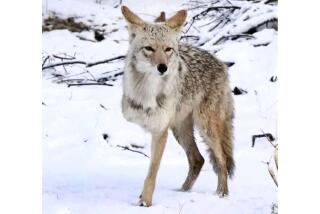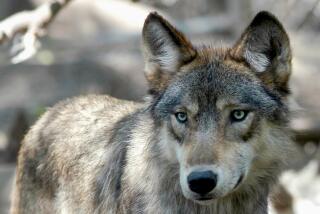Bison are Camp Pendleton’s royal grunts

They roam freely over the grassy hills, American royalty in a most unusual setting.
Nearby, young Marines are being tutored in the controlled application of violence, but the 147 bison of Camp Pendleton, shaggy, rust-colored and majestic, are protected by federal law.
Their piercing dark eyes, powerful appearance and sharp horns seem to warn intruders to their realm to stand clear. If they sense a threat to their young, they will charge.
On warm days, they like the shade of the coastal oak trees; on cold nights, they huddle in the ravines to escape the wind.
The Marine Corps makes no attempt to fence them.
Instead, a staff of civilian biologists monitors the movements of the population, sometimes by helicopter. If the bison wander too close to the artillery or live-fire ranges, training is halted.
Once, the bison surrounded a vehicle containing the commandant, blocking his way. The four stars on his collar gave him absolute authority over 170,000 Marines but meant nothing to the bison. He waited until the beasts, in their haughty, self-assured manner, slowly decided to move.
It all started in the mid-1970s, when the San Diego Zoo gave a dozen bison, which it did not have space for, to Camp Pendleton. Space was not a problem at the 125,000-acre base.
The federal Department of the Interior -- which features the bison on its seal -- manages about 7,000 bison in seven national wildlife refuges and five national parks. There’s a smallish group in San Francisco’s Golden Gate Park and a herd at a nature preserve on Catalina Island.
The rest of the nation’s half a million bison are mostly on privately owned lands. The Camp Pendleton population, given its isolation, may prove a genetic boon to species preservation efforts.
Last week, Interior Secretary Dirk Kempthorne announced plans for a bison working group to involve various federal agencies, including the Department of Defense, to develop an updated bison management plan for federal lands. One possibility might be to place bison herds on other bases with open spaces.
The department, and its subordinate agencies, has responsibility for many species, but the bison is a kind of first among equals.
“It captures the all-American values better than other critters,” said Kaush Arha, deputy assistant Interior secretary for fish, wildlife and parks. “It’s big, bold and likes to go where it wants to go. In many ways it demonstrated manifest destiny before we humans followed.”
American bison, sometimes mistakenly called buffalo, are related to the African buffalo and the Asian water buffalo, but scientists disagree on how close the link is.
One of the federal working group’s concerns will be the historic mixing of bison and cattle, which has diluted the bison gene.
Even before the working group was announced, bison specialists from Texas A&M University were studying the Camp Pendleton bison to see if they have any cattle DNA left from their pre-military-base ancestors. If the base’s bison prove to be “pure,” some might be redeployed elsewhere to reinvigorate the species.
Meanwhile, they roam and reproduce, just as their ancestors did in the middle of the 19th century, when an estimated 20 million to 60 million of them dominated the Western plains.
And they are not the only endangered species at Camp Pendleton -- the base has 17 protected or endangered species, mostly birds.
Amphibious assault training has to be curtailed during nesting season. And the Pacific field mouse has a liking for the areas near firing ranges.
Mostly, the bison live near the northeastern reach of the base, near the Cleveland National Forest. There’s plentiful grass and two spring-fed ponds. Fire breaks provide the bison with easy walking paths.
Large gatherings are rare. It’s more common to find groupings of several cows and several calves, for example, or maybe a bull and his harem.
To get a fix on the genetic composition and health of the population, the biologists euthanized a 1,400-pound bull and an 800-pound cow.
The results of the blood and DNA testing were encouraging: They had no cattle genes and no signs of ill health.
On a recent morning, a herd of nine of the Camp Pendleton bison was grazing quietly. They kept a wary eye on the humans nearby but showed no signs of being frightened.
The sun was warm and the air still except for the sound of an acorn woodpecker. A hawk made lazy circles in the sky. The bison were unhurried.
“They’re the symbol of the American West,” said Eric L. Kershner, the top wildlife biologist on base.
Perry is a Times staff writer.
More to Read
Start your day right
Sign up for Essential California for news, features and recommendations from the L.A. Times and beyond in your inbox six days a week.
You may occasionally receive promotional content from the Los Angeles Times.






